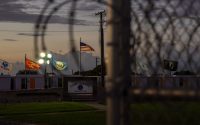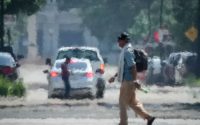Damaged Tracks Caused Montana Amtrak Derailment, Investigators Say
Worn and poorly-maintained train tracks that should have been replaced caused the 2021 derailment of an Amtrak train in Montana that killed three people and injured 49 others, federal investigators said Thursday.
The derailment occurred on Sept. 25, 2021, near Joplin, about 150 miles northeast of Helena, Mont. The accident sent the train’s eight passenger cars careening off the BNSF Railway, with four toppling onto their sides, forcing rescuers to extricate passengers.
The crash could have been avoided if federal regulations that required replacing the rail — which was worn down, misaligned and would move up and down with the train’s weight — had been followed and if a rail inspector had not been so overworked that he had had time to properly assess the track, according to a report by the National Transportation Safety Board.
“The track inspector’s workload likely prevented him from performing a timely walking inspection of the track in the area of the derailment,” investigators said in the report, noting that BNSF Railway Company, the freight railroad that owned and maintained the tracks, had not properly managed employee workloads.
According to the report, the inspector tasked with checking that particular piece of track had regularly been working more than 13 hours a day in the two weeks leading up to the crash; in the four days before, he had worked more than 57 hours.
The inspector had also raised concerns about the portion of track in question, and just two days before the crash, he had driven past the site but did not get out of his vehicle to view it on foot, the report said. “The most likely reason that the track inspector did not perform a walking inspection of the derailment curve in about a year is that he did not have time,” federal investigators said, noting that the site had last been inspected on foot in the fall of 2020.
Passengers in the derailment were so badly injured because they had not been restrained properly in the train cars and because they were ejected through windows, the report found, adding that higher standards were needed to ensure that windows did not fall out of their frames during an accident. Investigators also recommended that the Federal Railroad Administration research ways to mitigate passenger injuries in derailments, possibly by installing seatbelts.
Several wrongful-death lawsuits against Amtrak and BNSF have been filed in the derailment.
BNSF Railway said that while it had not yet fully reviewed the findings of the report, it was “committed to safety” across its rail network and regularly conducted inspections of locomotives, track, rail and bridges.
“BNSF inspections meet all federal requirements, and we are committed to timely maintenance, repair and replacement whenever issues or potential issues are detected,” Lena Kent, a spokeswoman for the rail network, said in an email. She added that before the report was released, the rail operator had begun installing track inspection technology on locomotives and that more than 4,000 detectors had been installed on rail tracks to collect and disseminate information to help “optimize the safety and reliability of our network and equipment.”
Representatives for Amtrak did not immediately respond to a request for comment on Thursday.
Jennifer Homendy, chair of the N.T.S.B., implored track owners to ensure that inspectors had the time, support and resources needed to do their work. “This tragedy is a powerful reminder that there’s no substitute for robust track inspection practices,” Ms. Homendy said in a statement.
Michael Levenson contributed reporting.


